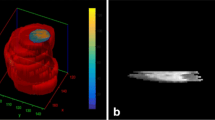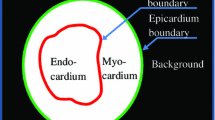Abstract
The sliding motion along the boundaries of discontinuous regions has been actively studied in B-spline free-form deformation framework. This study focusses on the sliding motion for a velocity field-based 3D+t registration. The discontinuity of the tangent direction guides the deformation of the object region, and a separate control of two regions provides a better registration accuracy. The sliding motion under the velocity field-based transformation is conducted under the \(\alpha\)-Rényi entropy estimator using a minimum spanning tree (MST) topology. Moreover, a new topology changing method of the MST is proposed. The topology change is performed as follows: inserting random noise, constructing the MST, and removing random noise while preserving a local connection consistency of the MST. This random noise process (RNP) prevents the \(\alpha\)-Rényi entropy-based registration from degrading in sliding motion, because the RNP creates a small disturbance around special locations. Experiments were performed using two publicly available datasets: the DIR-Lab dataset, which consists of 4D pulmonary computed tomography (CT) images, and a benchmarking framework dataset for cardiac 3D ultrasound. For the 4D pulmonary CT images, RNP produced a significantly improved result for the original MST with sliding motion (p<0.05). For the cardiac 3D ultrasound dataset, only a discontinuity-based registration indicated activity of the RNP. In contrast, the single MST without sliding motion did not show any improvement. These experiments proved the effectiveness of the RNP for sliding motion.






Similar content being viewed by others
References
Yin Y, Hoffman EA, Lin CL: Mass preserving nonrigid registration of CT lung images using cubic B-spline. Medical physics 36(9), 4213–4222,2009
Rueckert D, Sonoda LI, Hayes C, Hill DLGAHDLG, Leach MOALMO, Hawkes DJAHDJ, Sonoda, LI, Hayes C: Nonrigid registration using free-form deformations: application to breast MR images. Medical Imaging, IEEE Transactions on 18(8), 712–721,1999. https://doi.org/10.1109/42.796284
Piella G, De Craene M, Butakoff C, Grau V, Yao C, Nedjati-Gilani S, Penney GP, Frangi AF: Multiview diffeomorphic registration: Application to motion and strain estimation from 3D echocardiography. Medical image analysis 17(3), 348–364,2013
De Craene M, Piella G, Camara O, Duchateau N, Silva E, Doltra A, D’hooge J, Brugada J, Sitges, M, Frangi AF: Temporal diffeomorphic free-form deformation: Application to motion and strain estimation from 3D echocardiography. Medical Image Analysis 16(2), 427–450,2012. https://doi.org/10.1016/j.media.2011.10.006
Avants BB, Tustison NJ, Stauffer M, Song G, Wu B, Gee JC: The Insight ToolKit image registration framework. Frontiers in neuroinformatics 8,2014
Klein S, Staring M, Murphy K, Viergever MA, Pluim JPW: Elastix: a toolbox for intensity-based medical image registration. IEEE transactions on medical imaging 29(1), 196–205,2010
Murphy K, Van Ginneken B, Reinhardt JM, Kabus S, Ding K, Deng X, Cao K, Du K, Christensen GE, Garcia V, et al: Evaluation of registration methods on thoracic CT: the EMPIRE10 challenge. IEEE transactions on medical imaging 30(11), 1901–1920,2011
Lu W, Olivera GH, Chen Q, Chen ML, Ruchala KJ: Automatic re-contouring in 4d radiotherapy. Physics in Medicine & Biology 51(5), 1077,2006
Wang H, Garden AS, Zhang L, Wei X, Ahamad A, Kuban DA, Komaki R, O’Daniel J, Zhang Y, Mohan R, et al: Performance evaluation of automatic anatomy segmentation algorithm on repeat or four-dimensional computed tomography images using deformable image registration method. International Journal of Radiation Oncology* Biology* Physics 72(1), 210–219,2008
Sharp G, Fritscher KD, Pekar V, Peroni M, Shusharina N, Veeraraghavan H, Yang J: Vision 20/20: perspectives on automated image segmentation for radiotherapy. Medical physics 41(5),2014
Ramadaan IS, Peick K, Hamilton DA, Evans J, Iupati D, Nicholson A, Greig L, Louwe RJ: Validation of varian’s smartadapt® deformable image registration algorithm for clinical application. Radiation Oncology 10(1), 1–9,2015
Boldea V, Sharp GC, Jiang SB, Sarrut D: 4d-ct lung motion estimation with deformable registration: quantification of motion nonlinearity and hysteresis. Medical physics 35(3), 1008–1018,2008
Yang D, Lu W, Low DA, Deasy JO, Hope AJ, El Naqa I: 4d-ct motion estimation using deformable image registration and 5d respiratory motion modeling. Medical physics 35(10), 4577–4590,2008
Li X, Wang X, Li Y, Zhang X: A 4d imrt planning method using deformable image registration to improve normal tissue sparing with contemporary delivery techniques. Radiation Oncology 6(1), 83,2011
Jaffray DA, Lindsay PE, Brock KK, Deasy JO, Tomé WA: Accurate accumulation of dose for improved understanding of radiation effects in normal tissue. International Journal of Radiation Oncology* Biology* Physics 76(3), S135–S139,2010
Niu CJ, Foltz WD, Velec M, Moseley JL, Al-Mayah A, Brock KK: A novel technique to enable experimental validation of deformable dose accumulation. Medical physics 39(2), 765–776,2012
Hua R, Pozo JM, Taylor ZA, Frangi AF: Multiresolution eXtended Free-Form Deformations (XFFD) for non-rigid registration with discontinuous transforms. Medical Image Analysis 36, 113–122,2017
Schmidt-Richberg A, Werner R, Handels H, Ehrhardt J: Estimation of slipping organ motion by registration with direction-dependent regularization. Medical image analysis 16(1), 150–159,2012
Papież BW, Heinrich MP, Fehrenbach J, Risser L, Schnabel JA: An implicit sliding-motion preserving regularisation via bilateral filtering for deformable image registration. Medical image analysis 18(8), 1299–1311,2014
Wu Z, Rietzel E, Boldea V, Sarrut D, Sharp GC: Evaluation of deformable registration of patient lung 4DCT with subanatomical region segmentations. Medical physics 35(2), 775–781,2008
Delmon V, Rit S, Pinho R, Sarrut D: Registration of sliding objects using direction dependent B-splines decomposition. Physics in medicine and biology 58(5), 1303,2013
Ledesma-Carbayo MJ, Kybic J, Desco M, Santos A, Suhling M, Hunziker P, Unser M: Spatio-temporal nonrigid registration for ultrasound cardiac motion estimation. IEEE transactions on medical imaging 24(9), 1113–1126,2005
Heyde B, Barbosa D, Claus P, Maes F, D’hooge J: Three-dimensional cardiac motion estimation based on non-rigid image registration using a novel transformation model adapted to the heart. In: International Workshop on Statistical Atlases and Computational Models of the Heart, 2012, pp 142–150
Rueckert D, Aljabar P, Heckemann RA, Hajnal JV, Hammers A: Diffeomorphic registration using B-splines. In: International Conference on Medical Image Computing and Computer-Assisted Intervention, 2006, pp 702–709
Hero AO, Ma B, Michel OJJ, Gorman J: Applications of entropic spanning graphs. IEEE signal processing magazine 19(5), 85–95,2002
Neemuchwala H, Hero A, Carson P: Image matching using alpha-entropy measures and entropic graphs. Signal processing 85(2), 277–296,2005
Neemuchwala H, Hero AO: Entropic graphs for registration. Multi-sensor image fusion and its applications, 2005
Oubel E, De Craene M, Hero AO, Pourmorteza A, Huguet M, Avegliano G, Bijnens BH, Frangi, A.F.: Cardiac motion estimation by joint alignment of tagged MRI sequences. Medical image analysis 16(1), 339–350,2012
Staring M, Van Der Heide UA, Klein S, Viergever MA, Pluim JPW: Registration of cervical MRI using multifeature mutual information. IEEE transactions on medical imaging 28(9), 1412–1421,2009
Hamrouni S, Rougon N, Prêteux F: Multi-feature statistical nonrigid registration using high-dimensional generalized information measures. Medical Image Computing and Computer-Assisted Intervention–MICCAI, 2011, pp 524–531
Sabuncu MR, Ramadge P: Using Spanning Graphs for Efficient Image Registration. IEEE Transactions on Image Processing 17(5), 788–797,2008. https://doi.org/10.1109/TIP.2008.918951
Rivaz H, Karimaghaloo Z, Collins DL: Self-similarity weighted mutual information: a new nonrigid image registration metric. Medical image analysis 18(2), 343–358,2014
Eppenhof KAJ, Lafarge MW, Moeskops P, Veta M, Pluim JPW: Deformable image registration using convolutional neural networks. In: Medical Imaging 2018: Image Processing 10574, 105740S,2018
Wu G, Kim M, Wang Q, Munsell BC, Shen D: Scalable high-performance image registration framework by unsupervised deep feature representations learning. IEEE Transactions on Biomedical Engineering 63(7), 1505–1516,2016
de Vos BD, Berendsen FF, Viergever MA, Sokooti H, Staring M, Išgum I: A deep learning framework for unsupervised affine and deformable image registration. Medical image analysis 52, 128–143,2019
Vania M, Mureja D, Lee D: Automatic spine segmentation from CT images using Convolutional Neural Network via redundant generation of class labels. Journal of Computational Design and Engineering, 2019
Fu Y, Lei Y, Wang T, Curran WJ, Liu T, Yang X: Deep learning in medical image registration: a review. Physics in Medicine & Biology, 2020
Krebs J, Mansi T, Delingette H, Zhang L, Ghesu FC, Miao S, Maier AK, Ayache N, Liao R, Kamen A: Robust non-rigid registration through agent-based action learning. In: International Conference on Medical Image Computing and Computer-Assisted Intervention, Springer, 2017, pp 344–352
Balakrishnan G, Zhao A, Sabuncu MR, Guttag J, Dalca AV: An unsupervised learning model for deformable medical image registration. In: Proceedings of the IEEE conference on computer vision and pattern recognition, 2018, pp 9252–9260
Yu S, Giraldo LGS, Jenssen R, Principe JC: Multivariate extension of matrix-based renyi’s \(\alpha\)-order entropy functional. IEEE Transactions on Pattern Analysis and Machine Intelligence, 2019
Yu S, Wickstrøm K, Jenssen R, Principe JC: Understanding convolutional neural networks with information theory: An initial exploration. IEEE Transactions on Neural Networks and Learning Systems, 2020
Rényi A: On measures of entropy and information. In: Proceedings of the Fourth Berkeley Symposium on Mathematical Statistics and Probability, Volume 1: Contributions to the Theory of Statistics. The Regents of the University of California, 1961
Pál D, Póczos B, Szepesvári C: Estimation of Rényi entropy and mutual information based on generalized nearest-neighbor graphs. In: Advances in Neural Information Processing Systems, 2010, pp 1849–1857
Bae J: Advanced segmentation algorithms using numerical model and graph theory-Application to the lung images. Ph.D. thesis, 2016. https://hdl.handle.net/10371/119889
Cohen B, et al: New maximum likelihood motion estimation schemes for noisy ultrasound images. Pattern Recognition 35(2), 455–463,2002
Castillo R, Castillo E, Guerra R, Johnson VE, McPhail T, Garg AK, Guerrero T: A framework for evaluation of deformable image registration spatial accuracy using large landmark point sets. Physics in medicine and biology 54(7), 1849,2009
Metz CT, Klein S, Schaap M, van Walsum T, Niessen WJ: Nonrigid registration of dynamic medical imaging data using nd+ t b-splines and a groupwise optimization approach. Medical image analysis 15(2), 238–249,2011
Fechter T, Baltas D: One shot learning for deformable medical image registration and periodic motion tracking. IEEE Transactions on Medical Imaging, 2020
Klein S, Pluim JPW, Staring M, Viergever MA: Adaptive stochastic gradient descent optimisation for image registration. International journal of computer vision 81(3), 227,2009
Tobon-Gomez C, De Craene M, Mcleod K, Tautz L, Shi W, Hennemuth A, Prakosa A, Wang, H, Carr-White G, Kapetanakis S, et al: Benchmarking framework for myocardial tracking and deformation algorithms: An open access database. Medical image analysis 17(6), 632–648,2013
Robbins H, Monro S: A stochastic approximation method. The annals of mathematical statistics, 1951, pp 400–407
Nocedal J: Updating quasi-Newton matrices with limited storage. Mathematics of computation 35(151), 773–782,1980
Author information
Authors and Affiliations
Corresponding author
Additional information
Publisher’s Note
Springer Nature remains neutral with regard to jurisdictional claims in published maps and institutional affiliations.
Rights and permissions
About this article
Cite this article
Bae, J.P., Yoon, S., Vania, M. et al. Spatiotemporal Free-Form Registration Method Assisted by a Minimum Spanning Tree During Discontinuous Transformations. J Digit Imaging 34, 190–203 (2021). https://doi.org/10.1007/s10278-020-00409-y
Received:
Revised:
Accepted:
Published:
Issue Date:
DOI: https://doi.org/10.1007/s10278-020-00409-y




